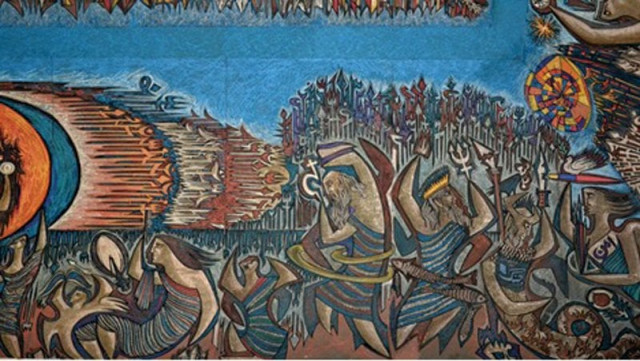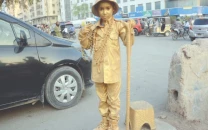A celestial tour de force: Twenty-seven years on, Sadequain’s work remains unfinished
The artist worked on the mural at Frere Hall from late 1986 to a few weeks before his death.

It is dangerous to try and describe the work. Is it a religious work with pagan undertones or vice versa? Analyses and commentaries proliferate and reduce the piece to mere pedantic expression. One must stand below and immerse themselves in the abyss of Sadequain's delirious soul. It is a labour of love that runs the gamut of human passions -- those who scan it in cold blood cannot comprehend it. It suffocates and sears. There is no landscape, no nature and nothing conventional. It is but primitive symbolism and the story of man's endless search for knowledge, combining the twin sides of the cosmos, order and chaos. The ideas that drive the work are fertile, untamed and all devouring, like the monsoon winds lashing across Sadequain's native land. The work is very busy, very effervescent.

The third panel revolves around the theme of the earth and the skies. Displayed in expansive calligraphy are the words ‘Arz-o-Samawat’ [Earth and the Skies] with a globe in the recess of (Z). The earth is shown dissected, and twin doves carrying the message of peace are in flight.
Sadequain had seen the Sistine Chapel ceiling and was in search of creating his own pièce de résistance. He wanted to create something that would be understood in the context of the space around it and could be viewed from any side to give a truly encompassing image. This could only be accomplished on a ceiling so one can behold the work in its mind-boggling entirety. The mural was painted in an astonishingly short time of six months. As if aware of the little time allotted to him in this world, Sadequain worked tirelessly from late 1986 to a few weeks before his death in 1987, determined to go out in a final burst of light. This work was a break from the calligraphy that had possessed him for several years. With this final piece at Frere Hall, his life had come full circle, since he had held his first exhibition there as well in 1956 which had been sponsored by his patron, Prime Minister Hussein Shaheed Suharwardy.
Something new
The medium of hardwood panels and oil pastels was a departure from Sadequain's modus operandi. Apart from his medium, Sadequain also digressed from his usual colours. He primarily used the complimentary colours of orange and blue in the painting, symbolising the twin elements of water and fire, the sustainer and destroyer, Vishnu and Shiva. The ceiling measures 70 feet long and 40 feet across and like Sadequain's other murals, hails the endeavours of man to conquer the primal forces around him. Unlike the "Saga of Labor" at Mangla Dam or the "Treasures of Time" at the State Bank Building of Pakistan, Sadequain tackled the celestial heavens.

The second panel centres a clock and Sadequain uses the theme of time through the ages to note man’s steps in science. As time moves, man learns more about the world around him, his disproportionately large hands reaching out to different planets, stars and balls of energy, sifting and groping for an understanding of what has puzzled him for millennia.
The ceiling has four sides, each with a version of the quest for knowledge with the universe in the centre. The message of the masterpiece, 'Ilm-o-Amal [Knowledge and Action]', is painted in the centre of the ceiling. Two eyes watch the whirling ball of fire, and angels. The slates on which Sadequain painted his calligraphy acknowledge him with the all-important Urdu alphabets of (S), (Q) and, (N) — the three syllables of his name.
Unfinished work
Unfortunately, the man who painted man's passage through time didn't have time himself. The brushes had moved with blinding speed, as if striving to keep pace with thoughts but not fast enough. The elixir that drove him like a dervish claimed him, in what was the biggest tragedy to sub-continental art, and he passed away on February 10, 1987 without having finished the ceiling mural. Large blue swathes of blue paint traverse the ceiling flanking the central eyes. The setting of the panels was a complex art and without the creator, the creation suffered in inept hands. Sadequain had wanted the side panels to be at an angle to the corners so they can meet unperturbed. The panels were set against the sloping wall and a ledge that protrudes from the sides hides the bottoms of the panels. A grave mistake indeed for it obstructs symbols like mangos and fishes, a representation of the twin symbols of Sadequain's native Amroha. Also the setting hides from the view a foot of work from all sides which adds to 220 square feet in total. That is the size is a mural in itself lost forever in the shadows of the overhanging ledges. Now, it suffers from an even bigger malaise, a leaking roof which threatens to cause irreparable damage to the masterpiece, a piece of art the likes of which Pakistan and the world may never see again.

The fourth panel is a mirror of the second one. The one difference is that instead of the modern clock, the instrument of time is an antiquated hourglass, top part of which shows the Earth in early stages as Pangaea. As time passes, in bottom half we see the Earth in its present form, with the continents separated.
The painting is eerily calling out to be finished, half-finished figures contort as if waiting to be given form so they too can embark for knowledge Sadequain so wished to attain.
Published in The Express Tribune, February 10th, 2014.



















COMMENTS
Comments are moderated and generally will be posted if they are on-topic and not abusive.
For more information, please see our Comments FAQ